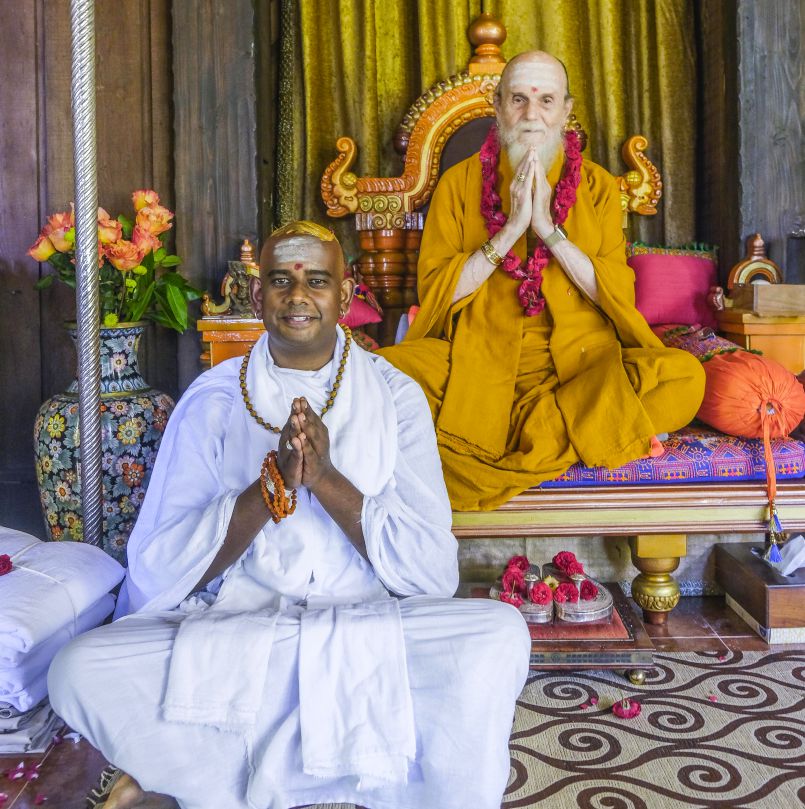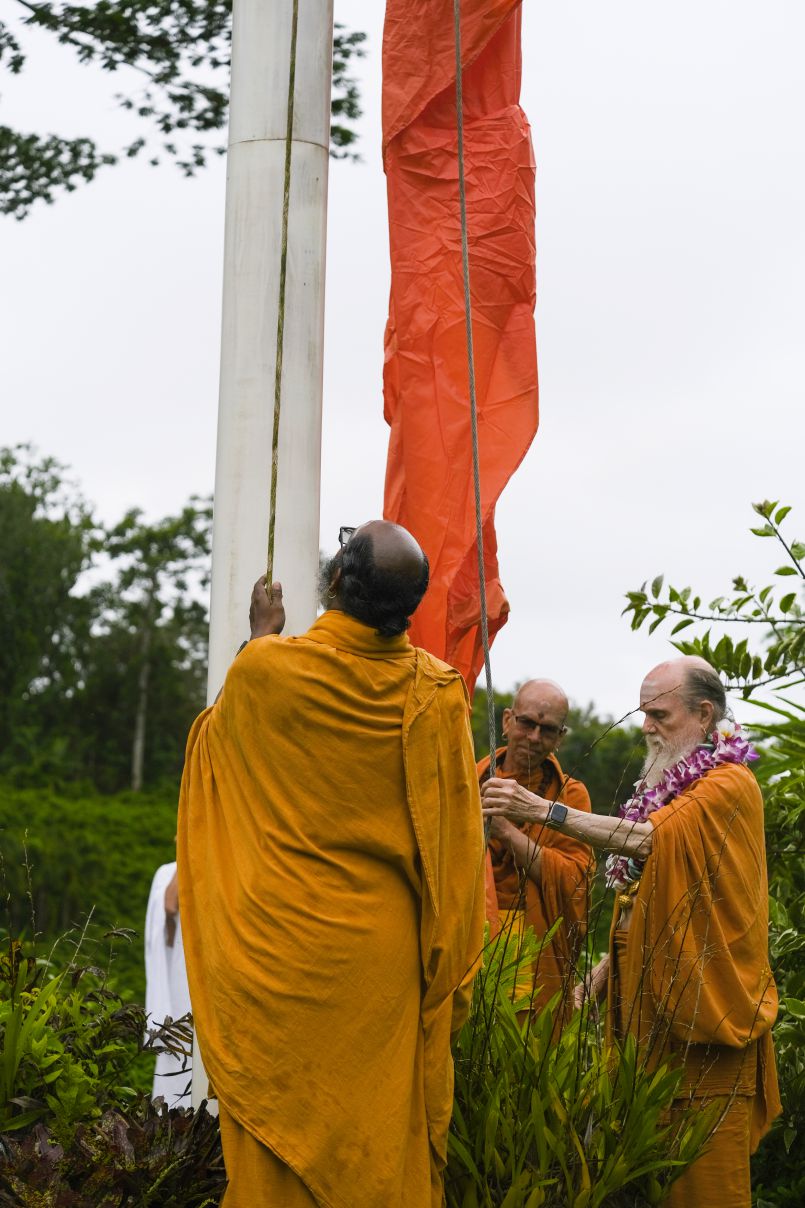Welcoming Our Newest Monastic: Sadhaka Vatshalanatha!

Jai Kailasa Parampara!
Jai Satguru Bodhinatha Veylanswami!
Jai Sivaya Subramuniyaswami!
Aum Namah Sivaya!
Just following our abhishekam of Lord Nataraja during the Ardra nakshatra yesterday, the monks gathered in the Guru Pitam to witness the taking of vows by our newest monastic, Sadhaka Vatshalanatha.
The following are excerpts from his four vows, which he read aloud to Bodhinatha and the attending monks:
THE SACRED VOW OF HUMILITY: known in Tamil as PANNIVU
Humility is the state of profound maturity in which the soul, immersed in the depths of understanding and compassion, radiates the qualities of mildness, modesty, reverent obeisance and unpretentiousness. There is an analogy in the Saivite tradition that compares the unfolding soul to wheat. When young and growing, the stalks of wheat stand tall and proud, but when mature their heads bend low under the weight of the grains they yield. Similarly, man is self-assertive, arrogant and vain only in the early stages of his spiritual growth. As he matures and yields the harvest of divine knowledge, he too bends his head. In the Tamil language this absence of pride or self-assertion is known as pannivu. Pannivu also means "jewel." In the Tirukural it is said that "Humility and pleasant words are the jewels that adorn a man; there are none other."
Humility does not consist in concealing our merits and virtues or in thinking ourselves worse or more ordinary than we are. Nor is it a pretended meekness. Rather it lies in not exalting ourselves before others for we perceive the grandeur of God Siva in every human being and reverently acknowledge Him there. Humility in this ideal is the awakened perception that "Siva is All." It is the inner being predominating over the outer nature.
THE SACRED VOW OF PURITY: known in Tamil as TIRIKARANNASUTTI
Purity is the pristine and natural state of the soul. It is not something which the monastic attains as much as that which he already is, and which becomes evident as the layers of adulterating experience and beclouding conceptions are dissipated. Purity is clarity and clearness in all dimensions of being. It is innocence as opposed to familiarity with the ways of the world. It is for monastics the observance of chastity, called brahmacharya. In Tamil purity is given its fullest expression in the term tirikarannasutti, which means "purity in mind, speech and body." These three--also called thought, word and deed--convey the fullness of the ideal of purity.
Purity does not consist in merely doing good and being good, though these are essential, nor is it an outward appearance or show of such goodness. It is primarily an inner quality, equally present in the saint who outwardly reflects the purity of his attainment and in the sage who inwardly rests in that same purity though his attainment may not be apparent. Purity is not a manner of behavior, though it may be reflected in our behavior, and there is no merit in taking on the appearance of being pure when one is not yet pure.
THE SACRED VOW OF OBEDIENCE: known in tamil as TAALVU ENUM TANMAI
Obedience is the state of willingness and cooperation in which the soul remains open and amenable to enlightened direction. For the monastic it is an unbroken pledge of trust in and surrender to the satguru, the guru parampara and the mystic process of spiritual evolution. In the Tamil language this definition of obedience is expressed in the term taalvu enum tanmai, which denotes "the quality or state of humble submission."
Obedience does not consist in blind submission and yielding to authority, nor in weakening our own will that it may be dominated by the will of another. Yet it is, in another sense, submission to a sacred purpose and the divine authority of the Second and Third Worlds. It is, for the monastic, an inner quality that allows him to remain consciously tractable and responsive. In the beginning, while the instinctive nature remains strong and there exists a sense of "I" and "mine," obedience is a surrendering of the ego to the soul or the instinctive nature to the spiritual nature. As long as the ego dominates the life of man, he will experience obedience as capitulation or subjection. As the soul unfolds and separateness is replaced by knowledge of the unity that pervades the universe, obedience is perceived as the union of minds and purpose, a state of harmony so complete that there can exist no distinction between him who gives and him who receives instruction or direction. True obedience is based on agreement, trust and knowledge, as opposed to passive servility, nonresistance or domination, which have ignorance and fear as their basis.
THE SACRED VOW OF CONFIDENCE: known in tamil as RAHASIYAM
Confidence is the state of trust in which the sacred teachings and sensitive or personal matters are not divulged to others. Spiritual matters must be protected and preserved by those to whom they are entrusted, never wantonly or indiscriminately revealed. When we confide in another, we do so with the assurance that sensitive and serious information will not be inappropriately disclosed. In the Tamil language confidence is known as rahasiyam, meaning "secret or mystery."
Confidence as applied to these Sacred Vows does not mean "certainty," "a belief in one's abilities" or "self-confidence." Rather it is a confiding, a trusting and a relying upon. It is the controlled sharing of privileged teachings or information that should not be disclosed, but held in confidentiality. In its most simple form it is the keeping of a secret.
Confidence for the monastic may be defined as wisdom in handling information. The monastic must learn to hold in strict secrecy all spiritual direction and esoteric laws entrusted to him, never revealing them unless specifically ordained to do so. He must realize the wisdom of Saint Yogaswami's statement that "Sacred is secret and secret is sacred," never treating the inner teachings as ordinary knowledge to be published or spoken of to the public or prematurely disclosed to devotees.
May Yogaswami, Gurudeva, and our entire guru-lineage, steadily guide Sadhaka Vatshalanatha from this and inner worlds.
Aum Namah Sivaya!
Aerial Photos – May 2023

Aum Namah Sivaya
We recently took a short survey flight with our drone, attempting to map out some future improvements along San Marga. While up there we took a few other shots just for fun. From the air, we're continually reminded of how lush and pure our island environment is. A perfect place of prana and a plethora of pretty plants.
"The whole world is an ashram in which all are doing sadhana. We must love the world, which is God's creation. Those who despise, hate and fear the world do not understand the intrinsic goodness of all."
Indian Swamis Visit the Monastery
Six monks and three grihastha devotees reached Kauai's shores after planning a trip for decades. They are from SGVP, Swaminarayan Gurukul Vishwavidya Pratishthanam, a major Swaminarayan institution based in Gujarat (and around the globe). They are led by HH Swami Shree Madhavpriyadasji Swami, a disciple of P.P.Sadguru Shastriji Maharaj Shree Dharamjivandasji Swami, the founder of ancient Gurukul system in modern era. Swamiji is one of 12 Hindu spiritual leaders governing the renowned Hindu Dharm Acharya Sabha, a leading organization of Hinduism for interfaith religious harmony. They spent two days discovering the Aadheenam and Iraivan Temple, meeting with Bodhinatha, exploring Kauai (yes, helicopters were involved!) and enjoying a bit of downtime from their intense daily service. Such a joy to be with them.
Sivajnani Nagappan arrives for Taskforce

Yesterday Sivajnani Nagappan arrived at Kauai Aadheenam, visiting from Malaysia. He's here for a few weeks on our taskforce program to help the monks with various projects. Welcome to Kauai Sivajnani! Aum Namah Sivaya.
2023 Nartana Ritau Homa and Flag Raising

Happy New Year of obhakta!
Yesterday our monks began the phase with our seasonal homa and a parade out to our flagpole to raise the new dvaja for this spring season and the new year as the Sun enters Mesha (Aries).
Here follows the passage from Saiva Dharma Shatras about how we should approach this new season:
Nartana Ritau, the season of Dancing with Siva, begins on Hindu New Year. This is the period of creation, the warm season, from mid-April through mid-August. The key word of this season is planning. The colors are orange, yellow-gold and all shades of green--orange for renunciation, yellow-gold for action, and green for regeneration. High above, the main Hindu flag flies the color orange, heralding the Nartana Ritau throughout this season, symbolizing sadhana and self-control. The other colors adorn smaller flags. This is the season of giving special attention to those in the grihastha ashrama. It is a time of awakening, renewal, review. The emphasis is on seeing ahead, planning for future years. It is a time of planning retreats and other activities for youths and adults for the entire year. During this time of looking forward, the Church's six-year plan is updated by the Guru Mahasannidhanam and stewards and another year added. The Saiva Dharma Shastras are studied; and any needed additions in supplementary manuals, representing new growth, are made.
The practical focus is completion of unfinished projects. Secular holidays to observe among the families include Mothers Day in May, Fathers Day in June and Grandparents Day in August. In the monastery intensive cleaning of buildings and grounds takes place. New clothing is issued and old garments mended.
This season of harvest and new growth is also the time to review and reestablish picking and planting routines for the gardens. It is a time for ordering seeds and plants for the year, of planting trees, fragrant vines and the annual crop. Review is made for scheduling the care of all realms of the Aadheenam. Kadavul temple and the Guru Temple are cleaned and renewed during this season, and the adjacent grounds receive special, abundant attention.
The daily sadhana is the Sivachaitanya Panchatantra: experiencing nada, jyoti, prana, shakti and darshana. In Sanskrit, it is a time of learning new shlokas and mantras. Shrine rooms are renewed and redecorated for the year, and the clothing of all is renewed in the Hindu style of the current fashion. It is a time of doing things for others, religious outreach. In the missions, Nartana Ritau is the time of bringing in new students and Church members. It is a time of hatha yoga and philosophical teaching.
The main festival of Nartana Ritau is Guru Purnima. The mathavasis hold special conclave on Vaikasi Vishakham, the full moon day of May.
Siddhidata Kulam’s New Building Frame Takes Shape
Siddhidata Kulam New Building Parts Arrived
San Marga Path Earthwork
New Electric People Mover Vehicle
A Sacred Journey to Kaua‘i Aadheenam

Hawaii Magazine recently published a glowing review of Kauai's Hindu Monastery, highlighting the breathtaking beauty of the temple and the peaceful atmosphere that envelops visitors. The reviewer, who visited the monastery on a sunny afternoon, was struck by the stunning architecture and the sense of serenity that pervaded the entire complex.
She noted the attention to detail and the reverence with which the space had been constructed, and was equally struck by the sense of calm that pervaded this space. She was left with a newfound appreciation for the traditions and spirituality of the Hindu religion.
See the article here: www.hawaiimagazine.com/a-sacred-journey-to-kauai-aadheenam
From Our Gurus' Teachings
Archives are now available through 2001. Light colored days have no posts. 1998-2001 coming later.
